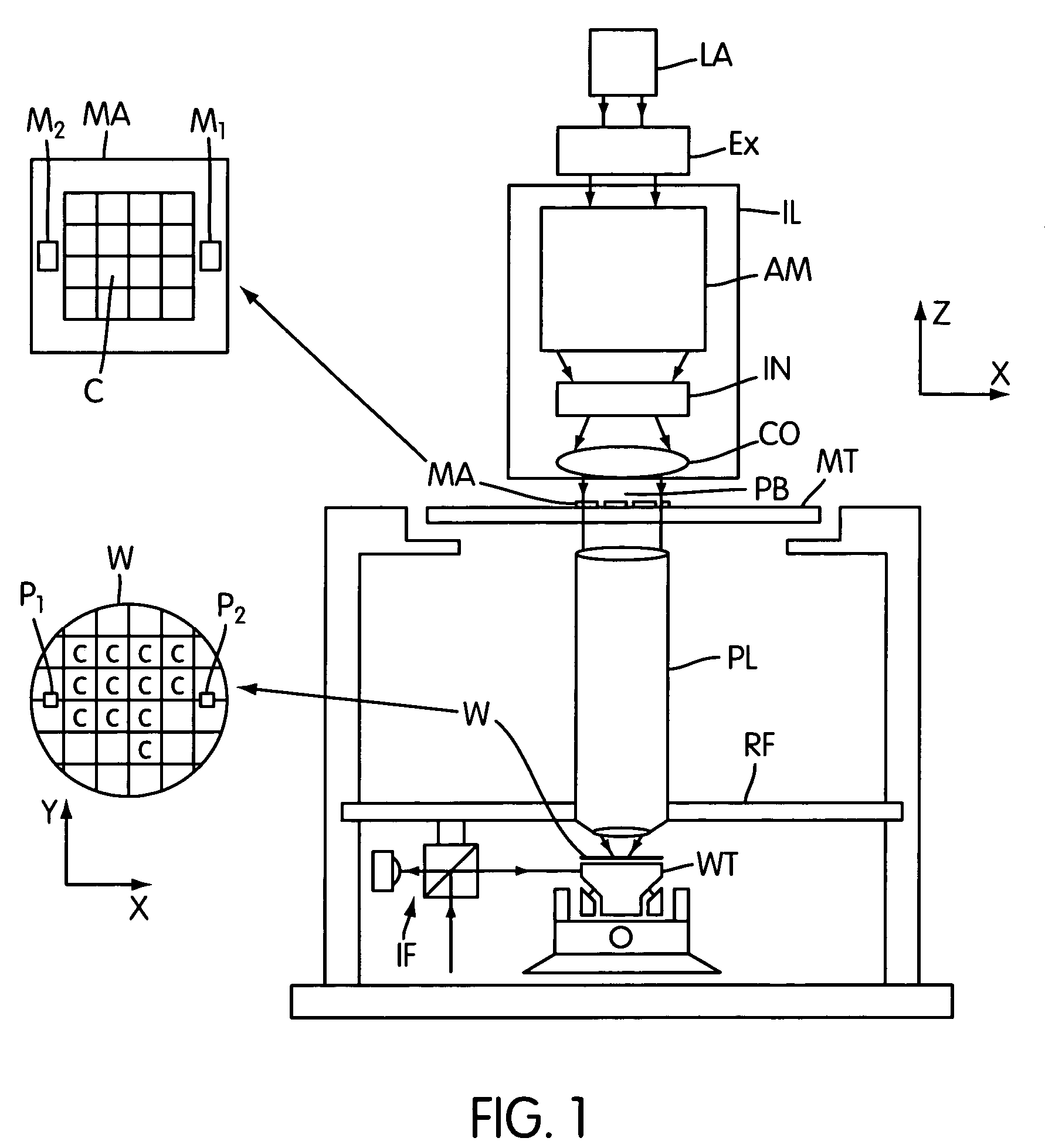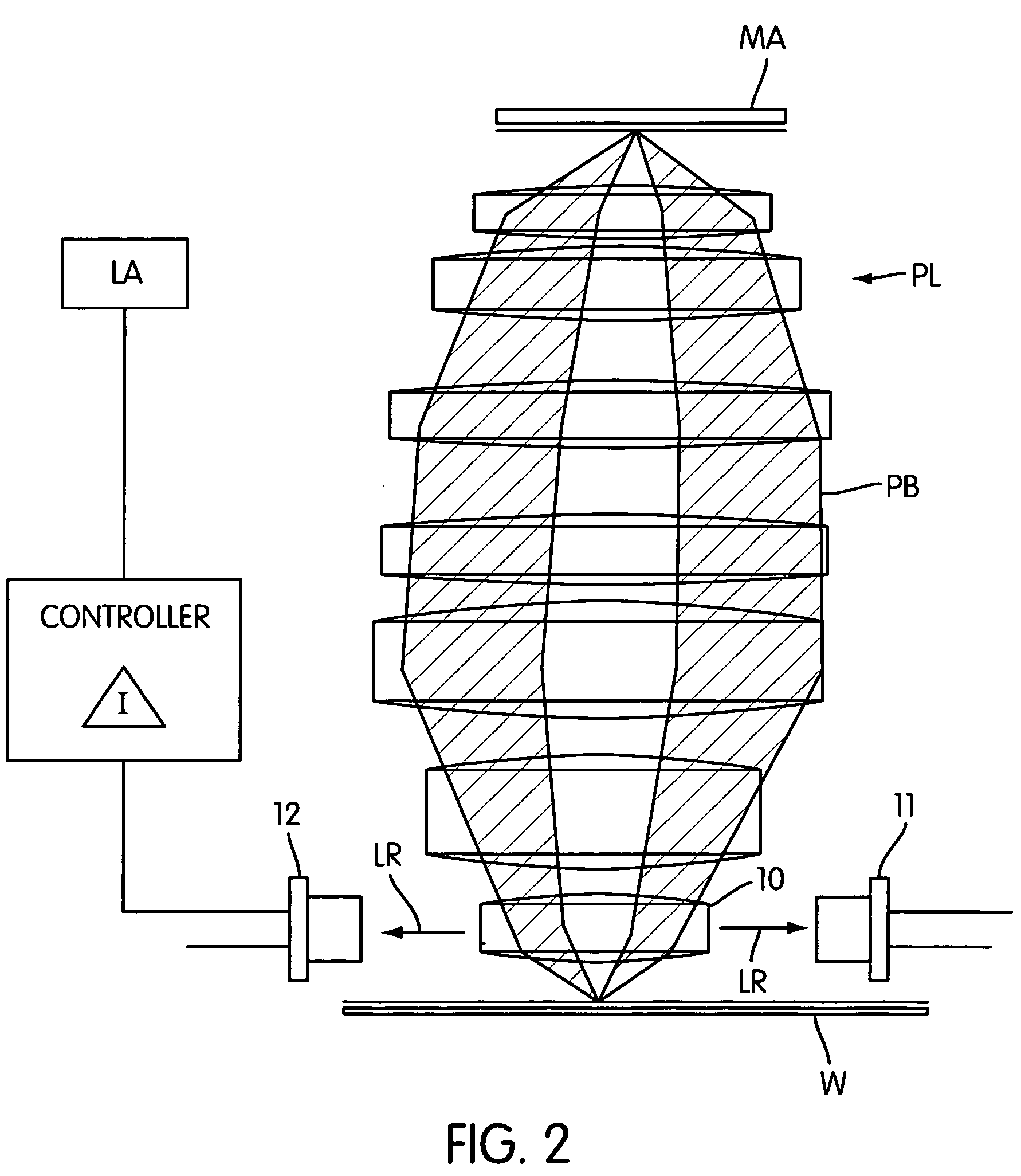Lithographic apparatus, method of manufacturing a device, and device manufactured thereby
a technology of lithographic apparatus and manufacturing method, applied in the direction of photomechanical apparatus, instruments, optics, etc., can solve the problems of significant and unpredictable variations, not all variations in absorption are easily or accurately predictable, and the exposure intensity profile can cross the resist threshold at the wrong point, so as to avoid or alleviate the
- Summary
- Abstract
- Description
- Claims
- Application Information
AI Technical Summary
Benefits of technology
Problems solved by technology
Method used
Image
Examples
embodiment 1
[0036]FIG. 1 schematically depicts a lithographic projection apparatus according to a particular embodiment of the invention. The apparatus comprises: a radiation system LA, Ex, IL, for supplying a projection beam PB of radiation (e.g. UV radiation); a first object table (mask table) MT for holding a mask MA (e.g. a reticle), and connected to first positioning system for accurately positioning the mask with respect to item PL; a second object table (substrate table) WT for holding a substrate W (e.g. a resist-coated silicon wafer), and connected to second positioning system for accurately positioning the substrate with respect to item PL; and a projection system (“lens”) PL (e.g. a quartz and / or CaF2 lens system or a catadioptric system comprising lens elements made from such materials) for imaging an irradiated portion of the mask MA onto a target portion C (comprising one or more dies) of the substrate W. As shown in FIG. 1, mask MA is provided with alignment marks M1 and M2 and s...
embodiment 2
[0047]FIG. 4 shows an arrangement which is essentially the same as that of FIG. 3, except that the detectors have been replaced by reflective elements 30-38 which direct the luminescence radiation to a single detector 39. The inner wall 40 of the projection lens system is also reflective and together with the reflective elements 30-38 forms a reflecting radiation guide. As shown in FIG. 4, one particular reflective element 36 receives luminescence radiation from a wedge-shaped portion 42 of the lens element 10 and reflects it round the radiation guide, as shown by the hatched region 44 to the detector 39. The luminescence radiation directed by all of the other reflective elements has been omitted for clarity, but its path is simply shown by the arrows.
[0048]Other suitable radiation guides can be used, such as optical fibres, to direct the luminescence radiation from different portions of the projection lens element 10 to the single detector 39.
embodiment 3
[0049]This embodiment can be the same as the preceding embodiments in all respects except that, as shown in FIG. 5, the luminescence radiation LR from the projection lens element 10 is viewed from outside the lens hood 50, which is incorporated into the machine for gas purging reasons. This simplifies the installation of the luminescence radiation sensor and also improves its subsequent accessibility.
[0050]Although in FIG. 5 detectors 11 and 12 are shown, as in the first embodiment, it is, of course, possible to replace these by a radiation guide and a single detector as in the second embodiment described above.
[0051]In this third embodiment, it will be seen that the luminescence radiation sensor system is located forward of the projection lens element 10 which is closest to the wafer W, rather than being provided in the same plane as the projection lens element 10 as shown in FIGS. 3 and 4. The sensor system detects luminescence radiation emitted from the face of the projection len...
PUM
| Property | Measurement | Unit |
|---|---|---|
| wavelength | aaaaa | aaaaa |
| size | aaaaa | aaaaa |
| size | aaaaa | aaaaa |
Abstract
Description
Claims
Application Information
 Login to View More
Login to View More - R&D
- Intellectual Property
- Life Sciences
- Materials
- Tech Scout
- Unparalleled Data Quality
- Higher Quality Content
- 60% Fewer Hallucinations
Browse by: Latest US Patents, China's latest patents, Technical Efficacy Thesaurus, Application Domain, Technology Topic, Popular Technical Reports.
© 2025 PatSnap. All rights reserved.Legal|Privacy policy|Modern Slavery Act Transparency Statement|Sitemap|About US| Contact US: help@patsnap.com



